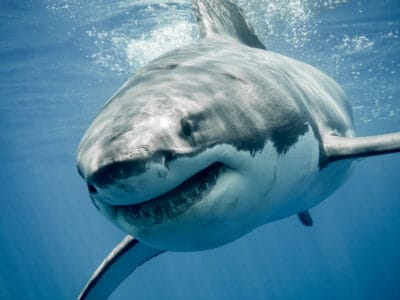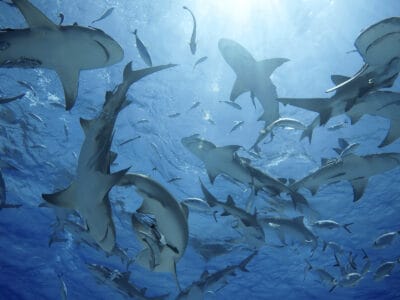With over three million lakes, 12,000 rivers, and numerous ponds and creeks, Alaska has everything it needs to be named the world’s most magnificent freshwater, sea, fly, and even ice fishing destination. Alaska’s waterways are home to more than 600 species of fish. This includes a variety of salmon, steelhead, halibut, Arctic grayling, northern pike, and Dolly Varden. One of the most popular freshwater species in Alaska is lake trout, also known as the “tyrant of the lakes” in the Native American language. This article is about the largest lake trout ever caught in Alaska and provides all the necessary details about the fish.
About the Lake Trout
©iStock.com/VvoeVale
You might be surprised to learn that the lake trout isn’t actually a true trout at all. It is a char fish, a close cousin of the trout, and is more related to the Arctic char.
The lake trout, also known as mackinaw, namaycush, lake char, touladi, and grey trout, is a freshwater char primarily found in lakes in northern North America. In Alaska, they are referred to as lakers. These fish are commonly sought after as food and sport fish.
The lake trout (Salvelinus namaycush) is the largest species of the char group. These salmon-like fish have dark or silvery scales, a light-yellow belly, and light-colored spots all over their fins. The lake trout’s body typically features worm-like, irregularly-shaped dots on a silvery-to-dark background. However, their color can vary significantly depending on the season, habitat, and population.
The absence of pink markings on the lake trout’s forked tail helps to distinguish them from other chars.
The “tyrant of the lakes” label comes from the fact that lake trout are one of North America’s top predators and, in some lakes, may even be the largest predatory fish due to their enormous size and aggressive feeding behavior. The diet of lake trout varies depending on the fish’s size and age, location, and available food.


Lake trout may mostly prey on other fish, including whitefish, sticklebacks, grayling, and sculpins, in their habitat. They also eat zooplankton, insect larvae, tiny aquatic insects, snails, and occasionally even young birds. Adult lake trout are known for eating their young when there aren’t many other fish species around.
How Big Do Lake Trouts Grow?
Lake trout typically grows to a weight of 5 to 15 pounds and a length of 20 to 30 inches. However, bigger sizes of up to 40 pounds are not uncommon. Since they have a lifespan of 10–20 years, how big these fish grow depends on their habitat and available prey.
Lake trout have an interesting growth pattern. Juveniles grow really fast, sometimes gaining as much as two to three inches per year. However, as they get older, their growth rate slows considerably. Adults (between 7 and 8 years old) grow slowly, with a growth rate of about an inch per year.
The Largest Lake Trout Caught in Alaska

©U.S. Fish and Wildlife Service / public domain – License
Also called “laker,” this huge fish measures between 20 and 30 inches in length and weighs between 15 and 40 pounds on average. They’re the largest freshwater fish in Alaska.
In a place known for lake trout that grow to massive sizes, the largest lake trout ever caught in Alaska was a record-breaking 47-pound fish caught in 1970. Twelve-year-old Daniel Thorsness caught this massive fish in Clarence Lake, a fly fishing lake in the Talkeetna Mountains, northeast of Talkeetna. The Alaska Department of Fish and Game claims that a healthy population of naturally reproducing lakers is still present in Clarence Lake.
The Largest Lake Trout in the World
The largest lake trout ever caught in the world was captured in 1961 in Lake Athabasca in the Saskatchewan region of Canada. The laker, measuring 60 inches in length and weighing 102 pounds, was caught by two anglers. Unfortunately, since it was captured in a gill net, this catch is not considered a sport fishing world record.
The fish recognized as the largest lake trout in the world was caught by angler Lloyd Bull on Great Bear Lake in the Northwestern region of Canada in 1995. He caught the 72-pound fish with a rod and reel. The same lake also produced the record holder for the longest lake trout in the world. Michael J. Sader caught the 52.5-inch-long fish in 2014.
Lake Trout Fishing in Alaska
Alaska has several clean lakes, and they’re home to a wide range of fish species. The lake trout, northern pike, and burbot are regular fly fishing targets in Alaska.
Lake trout can be found in deeper lowland lakes around the central Arctic coastal plain, as well as in the waters in the Brooks Range and Alaska Range in Alaska. These fish thrive in cold environments and are commonly found in waters with temperatures between 40 and 55 degrees Fahrenheit.
Lake trout prefer shallow water regions during spring. You may find them at a depth range of 10 to 30 feet throughout the fall and spring seasons. However, as the weather becomes warmer, they’ll move to deeper parts of their habitat. This means anglers need to follow the fish to deeper waters as the seasons change.
Anglers often catch these massive fish using spoons, flashers, and flies. In the fall, they spawn and cluster on shoals and reefs, but some migrate upstream, giving fishermen more angling opportunities. During winter, ice fishing often happens during the day, with many anglers catching fish that can weigh up to 20 pounds.
The preferred method for ice fishing for lake trout is to jig brightly-colored lures with whitefish, fresh herring, or smelt on them. The Kenai River, the Susitna River, and the Clarence River are popular fishing places for lake trout in Alaska. Various lakes in the interior region of the state, such as Crosswind Lake, Lake Louise, Tanada Lake, and Summit Lake, also have healthy lake trout populations.
Conclusion
Although lake trout fishing can be done all year, the recommended time to try to catch this fish in Alaska is during the summer. If you’re an angler fishing in Alaska, you can try your luck at catching this fish. Of course, you’ll do better with the help of a local guide, and you should also get the appropriate local license to fish in Alaska before setting out. If you’re lucky, you may be able to break the record for the largest lake trout ever caught in Alaska.
Up Next:
Credit: Source link































